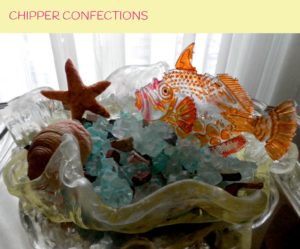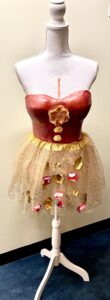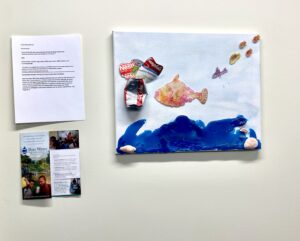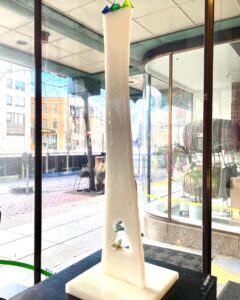 Linda Khachadurian is the founder of the sugar and chocolate art business, Chipper Confections, a volunteer-run 501(c)3 educational nonprofit, which works with the children in Haiti and Armenia. She is also a long-time friend and supporter of Pure Water for the World. Linda currently has an edible art show at The Karen Aqua Gallery in Cambridge, MA.
Linda Khachadurian is the founder of the sugar and chocolate art business, Chipper Confections, a volunteer-run 501(c)3 educational nonprofit, which works with the children in Haiti and Armenia. She is also a long-time friend and supporter of Pure Water for the World. Linda currently has an edible art show at The Karen Aqua Gallery in Cambridge, MA.
PWW asked Linda to share more about her edible art show with the PWW community.
Please tell us about your edible art exhibit.
 My solo edible art exhibition, entitled The Charitable Confectioner Presents, is on view through March 7, 2022 at the Karen Aqua Gallery in Cambridge. It’s based upon my show for Cambridge Community Television/Channel 9 called The Charitable Confectioner, which merges my passions for edible art and social causes. Each of the edible artworks represents a social cause that was addressed on the show and has accompanying informational materials hanging beside it.
My solo edible art exhibition, entitled The Charitable Confectioner Presents, is on view through March 7, 2022 at the Karen Aqua Gallery in Cambridge. It’s based upon my show for Cambridge Community Television/Channel 9 called The Charitable Confectioner, which merges my passions for edible art and social causes. Each of the edible artworks represents a social cause that was addressed on the show and has accompanying informational materials hanging beside it.
Edible mediums used to craft the art include: isomalt, gum paste, chocolate, potato starch paper, edible markers, edible spray paint, edible luster dust, and edible fabric.
The gallery is located at 438 Massachusetts Avenue and is open to the public on Mondays from 5-7pm, Wednesdays 4-6 pm, and Thursdays from 3-5 pm. One must reserve an appointment by e-mailing reserve@cctvcambridge.org .
Please share the inspiration(s) behind the pieces you created for this exhibit.
Each of the pieces represents a social cause that was addressed on an episode of The Charitable Confectioner. I have a direct involvement with, or connection to, many of the topics. I’ve worked on all three of the educational causes through my educational nonprofit, Charitable Confections.
- I learned about the topics of safe water (and sanitation) through writing my article for the Harvard Review of Latin America and my partnership with Pure Water for the World.
- I met and researched the work of the homeless rights advocate while working on a project in graduate school and also used to volunteer at a homeless shelter in NYC.
- I did research on cacao plantations in Ghana, where I learned about the slavery issue revolving around the harvesting of cacao beans.

The artworks/causes in this exhibition are:
- Perseverance (pictured right) – Isomalt painting – The lack of access to safe water worldwide.
- Maslow Reconfigured (pictured below)– Isomalt sculpture – The importance of education in developing nations: Armenia edition.
- T3 Tsunami – Isomalt painting – The lack of access to proper sanitation worldwide.
- The Cost of Greed II – Isomalt painting – The importance of responsible purchasing to offset slavery.
- Il Pagliaci – Sugar paste mask – The importance of education in developing nations: Haiti edition.
- Tree of Wisdom – Isomalt painting – The importance of implementing creative pedagogy to create a dynamic society.
- Blooms of Bounty – Isomalt and potato starch paper sculpture – The benefits of building with sustainable materials.
- Box of Betterment – Chocolate sculpture – Addressing the homelessness issue in the States.
- Good Health is the Best Accessory – Edible Dress (pictured above) – The importance of providing medical care to people living in poverty.
- Peace Please – Isomalt and sugar paste painting – The importance of peaceful co-existence.
I thought it would be fun to arrange the exhibition like an a la cart menu, so I crafted an isomalt and potato starch paper painting called Sage Sorbet, which serves as a figurative palette cleanser. There are also several small pieces at the end of the exhibition which serve as a visual dessert tableaux. Included on this table are a chocolate sculpture/vase, three artisan Armenian desserts displayed on isomalt plates, and an isomalt lamp.
What inspired you to get involved with edible art in the first place?
I kind of meandered into it. I’ve always been an arts and crafts geek. I studied sculpting in the clay medium as a hobby in my youth, and moved onto multiple mediums over the years, making everything from watercolor paintings to wooden figurines, to Ukrainian eggs, to clothing, hair accessories, and jewelry. Given that I was also a sugar fiend, it occurred to me one day that I should give a whirl to crafting with edible substances.
What inspired you to merge your passion of edible art with your passion for social justice issues?
One of my missions with the edible art has been to blur the divide between culinary and visual arts. It’s no easier to sculpt or paint with edible mediums than it is with traditional ones, yet edible art pieces are usually relegated to serving merely as decorations on a buffet table, with the sole purpose of being consumed, rather than being appreciated at length as visual works of art. One of the ways in which edible artworks generally differ from visual artworks is that they rarely have an intellectual depth to – or message behind –them.
Although great fine art pieces from past centuries were often portraits, still life tableaux, or landscapes –whether we’re talking about a Rembrandt portrait from the 1600s or a Monet landscape from the early 1900s — message driven art surfaced during the later period of modern art era, with artists such as Jean Michel Basquiat creating art that focused on dichotomies such as wealth and poverty and offered reflections on the legacy of slavery and colonialism. This type of message-driven art seems to be rather prevalent in the contemporary visual art scene, and I’d like to see more edible art having that depth and purpose behind it.
Also, I think that educating people about somber issues via a vehicle that inherently has that playfulness to it can be quite effective. I built the mission statement for my educational nonprofit around the Mother Teresa quote “Joy is a net of love by which you can catch souls,” because I thought that infusing a dash of creativity and whimsy into the presentation of dire situations would make the information more palatable to the masses and engage people who would normally turn an eye to other people’s suffering because it was too heavy of a topic for them.
Why Pure Water for the World?
I was introduced to Pure Water for the World’s impactful work in 2012 whilst writing an article about safe water in Haiti for the Harvard Review of Latin America (click to read). I was impressed by how passionate about and dedicated to the safe water cause the staff was. It seemed as though it was more of a calling for them rather than merely a manner in which to earn money. When I select nonprofits to support or collaborate with, the people behind the cause are as important as the cause itself. In the case of Pure Water for the World, both are top-notch.

Maslow Reconfigured
If a reader of this blog is interested in purchasing, could he/she/they do that?
Several, but not all, of the pieces are available for purchase. The available ones are marked as such in the accompanying materials. 100% of proceeds from Perseverance will go to Pure Water for the World, as will 5% of the other purchasable artworks.
** Please e-mail info@charitableconfections.org for a price list and details.
There will be a closing reception at the gallery on March 3, 2022 from 6-8pm. Guests interested in purchasing a piece can also do so then and take the artwork home with them.
**There is only one artwork that is available for purchase that will not have proceeds going to PWW (Maslow Reconfigured, 100% of sale proceeds which will go to the educational programs of Armenian Missionary Association of America).
The entire PWW team shares our heartfelt gratitude with Linda, for so many years of friendship and support, and for sharing her incredible talents and passions to create lasting change on our planet.
About Linda. Linda Khachadurian is a Beirut-born Armenian American medical editor, international educational nonprofit founder, sugar and chocolate artist, and host of The Charitable Confectioner on channel 9/Cambridge. Her online business, Chipper Confections, partners with Pure Water for the World — an organization she met while writing an article about safe water in Haiti for The Harvard Review of Latin America.
Websites : www.ChipperConfections.com & www.CharitableConfections.org
Instagram: @chipperconfections
